L6 Digestion
一、Nutrition
The Lactase persistence:

The process we uptake and utilize nutritions:
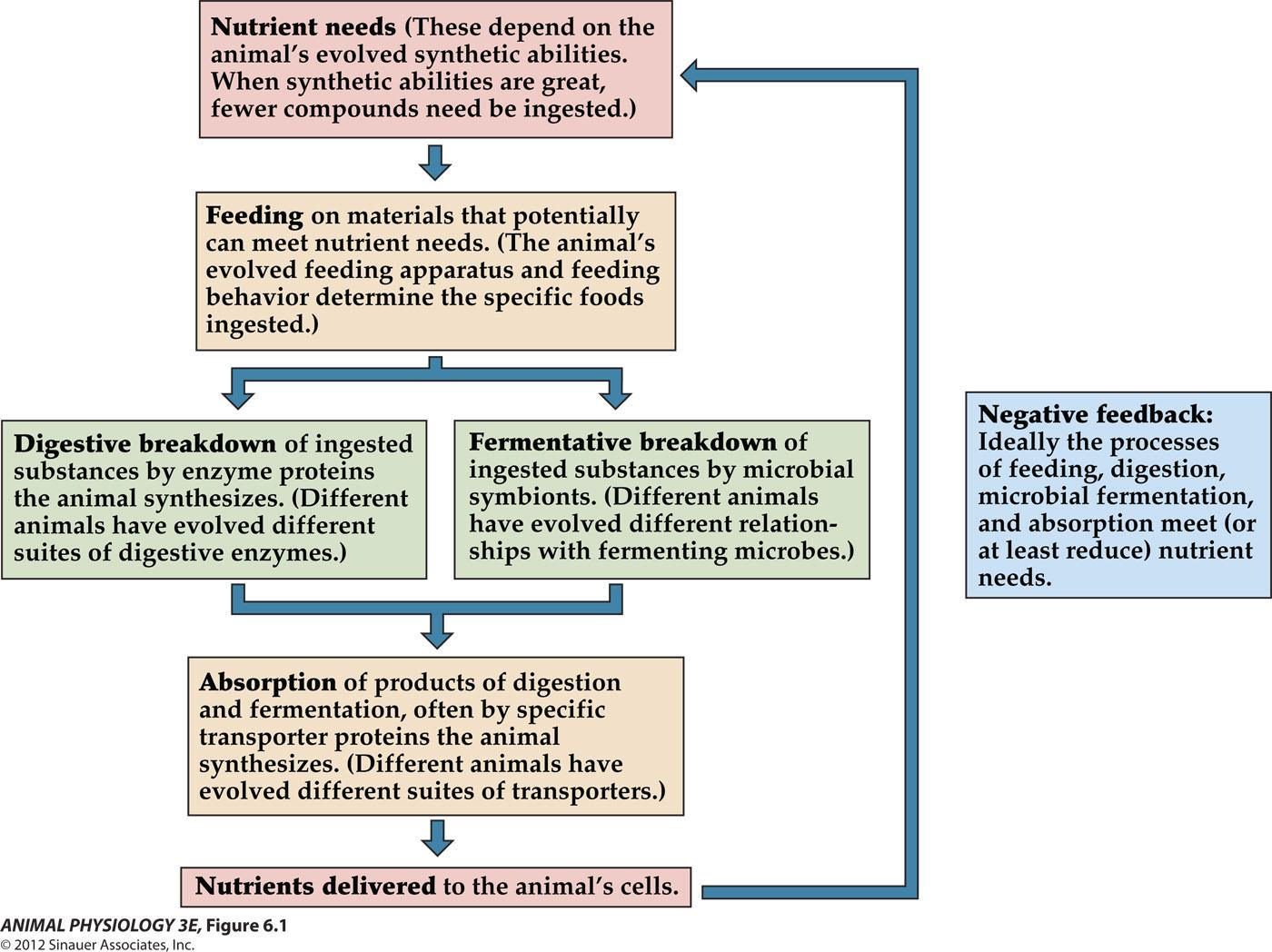
- Nutrient needs (These depend on the animal’s evolved synthetic abilities When synthetic abilities are great fewer compounds need be ingested.
- Feeding on materials that potentially can meet nutrient needs. (The animals evolved feeding apparatus and feeding behavior determine the specific foods ingested.)
- Digestive breakdown of ingested substances by enzyme proteins the animal synthesizes(Different animals have evolved different suites of digestive enzymes.
- Fermentative breakdown of ingested substances by microbial symbionts(Different animals have evolved different relation. ships with fermenting microbes.
- Absorption of products of digestion and fermentation, often by specific transporter proteins the animal synthesizes (Different animals have evolved different suites of transporters.
- Nutrients delivered to the animal’s cells
Negative feedback: Ideally the processes of feeding, digestion, microbial fermentation and absorption meet (or at least reduce) nutrient needs
The ratio of different nutrition in an adult human body:
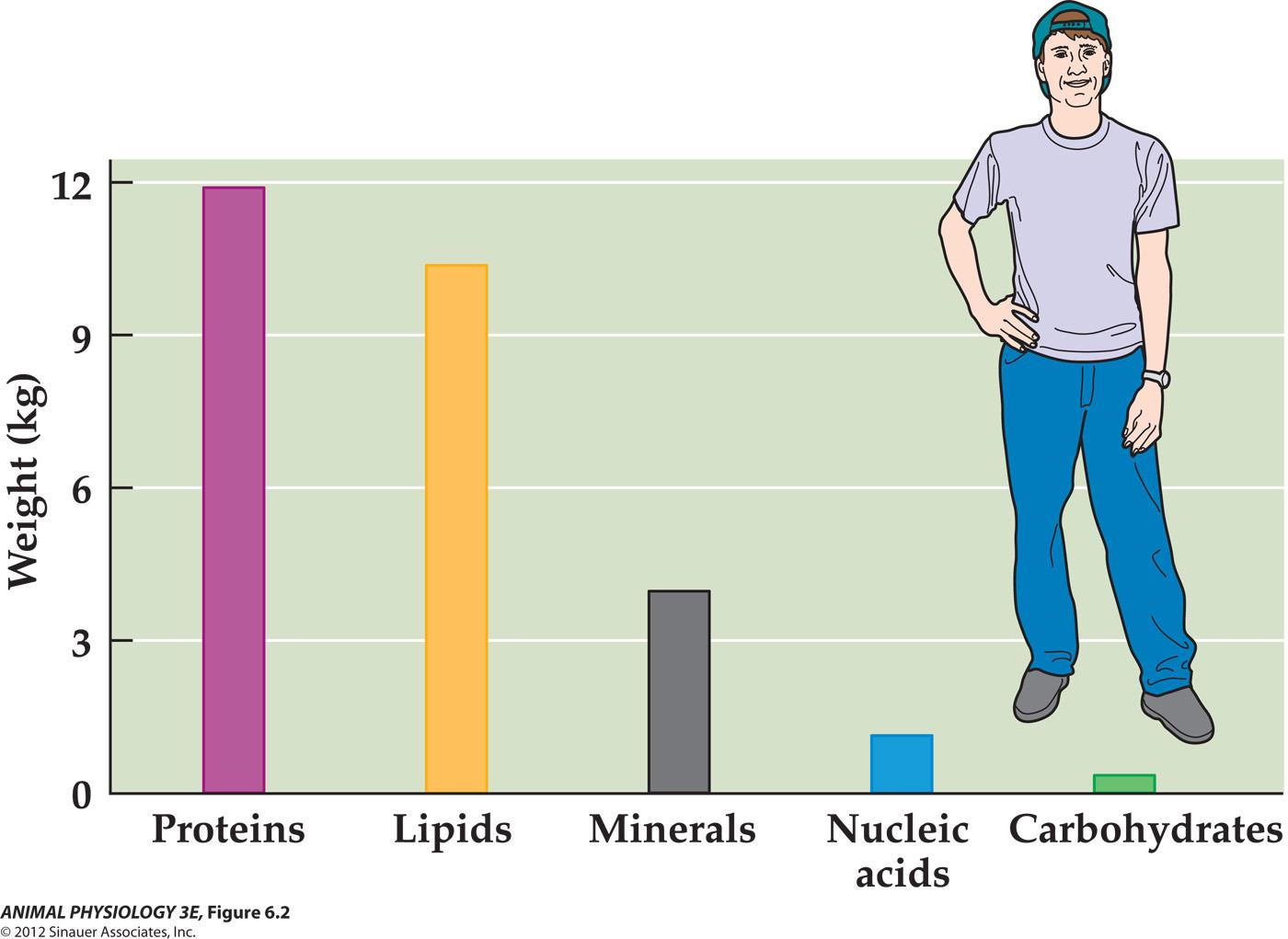
- Nitrogen is a limiting element in many ecosystems.
- Most animals, plants and microbes can not use gas N
2as a source of nitrogen for building proteins and other nitrogen-containing body components. - Proteins are about 16% nitrogen by weight
- Carbohydrate and lipids do not contain nitrogen
1. The amino acids
Standard amino acids – a set of 20 – 22 amino acids (all amino acids contain nitrogen!)
Essential amino acids – the amino acids that can not be adequately synthesized. Need to be acquired from food or outside source.
Non-essential amino acids – those amino acids that an animal is capable of synthesizing
200 other amino acids exist in organisms, but not involved in protein synthesis.
Some important amino acids:
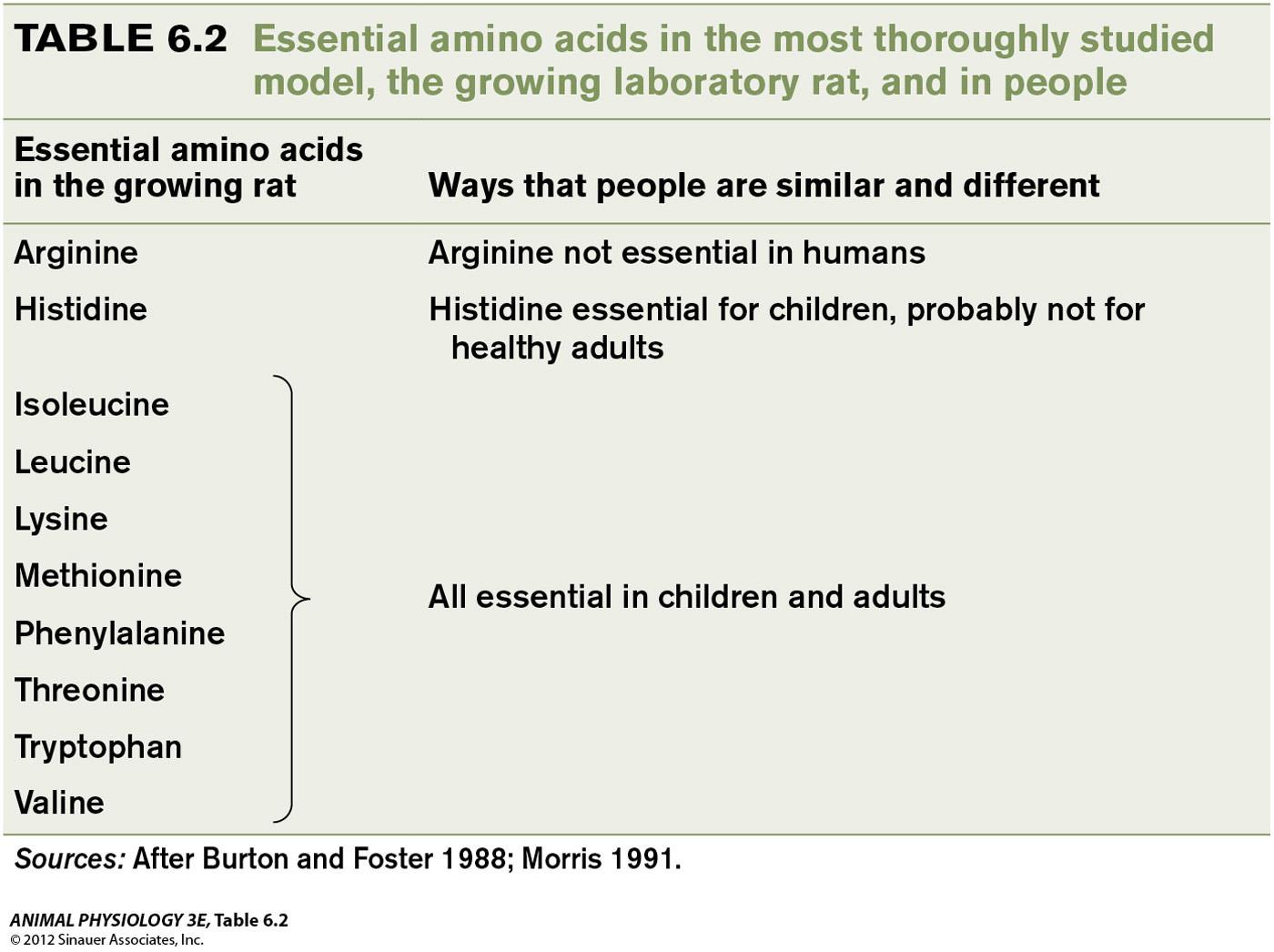
- Arginine not essential in humans
- Histidine essential for children, probably not for healthy adults
- Lysine deficiency is a serious health Problem for millions of people
- Mixing food is a mechanism to obtain essential amino acids.
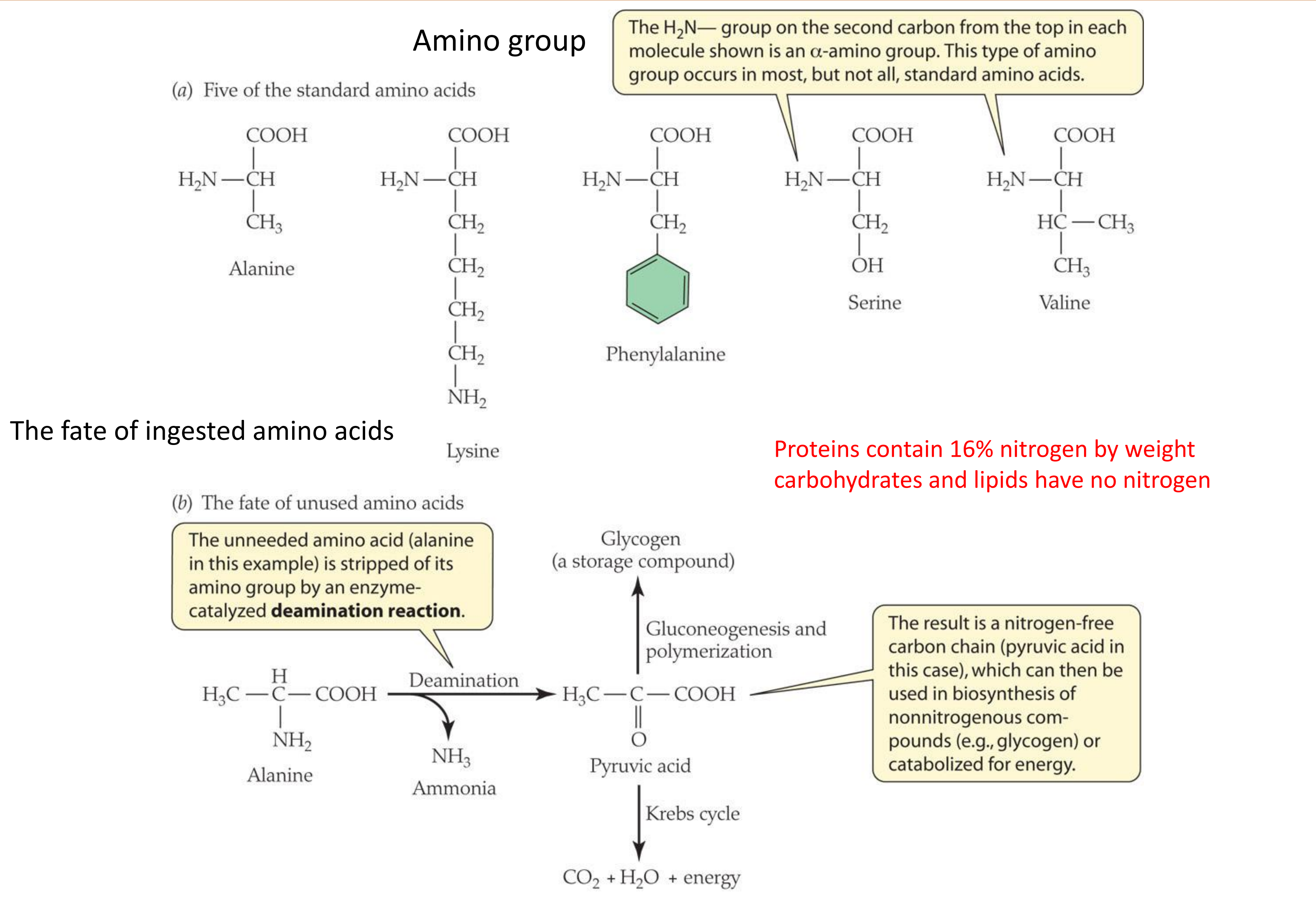
- The H
2N-group on the second carbon from the top in each molecule shown is an $\alpha$-amino group. This type of amino group occurs in most, but not all, standard amino acids - The unneeded amino acid (alanine in this example) is stripped of its amino group by an enzyme catalyzed deamination reaction
- The result is a nitrogen-free carbon chain(pyruvic acid in this case), which can then be used in biosynthesis of nonnitrogenous com- pounds(e.g, glycogen)or catabolized for energy
Animals, plants and most microbes can not use gas N2 as a source of nitrogen for building proteins or other nitrogen-containing body components
- Nitrogen is a limiting element
They require chemically combined, nongaseous (fixed) forms.
- Plants and algae use nitrate (NO3-), ammonium (NH4+) as their nitrogen source.
- Plants growth are held back due to the limited supply of nitrogen
- Herbivorous animals acquire nitrogen from proteins and other nitrogen-containing organic compounds of plants or algae
- Carnivores eat herbivores ….so the nitrogen insufficiency is a limiting factor in ecosystems
2. Lipids
Required for cell membrane and are the principal storage compounds of animals
Organic molecules contain carbon and hydrogen, nonpolar and hydrophobic
- Common lipids are fatty acids: hydrocarbon chains
- Triacylglycerols (fats and oils): three fatty acids molecules combined.
Fatty acids and triacylglycerols

Fatty acids symbols:
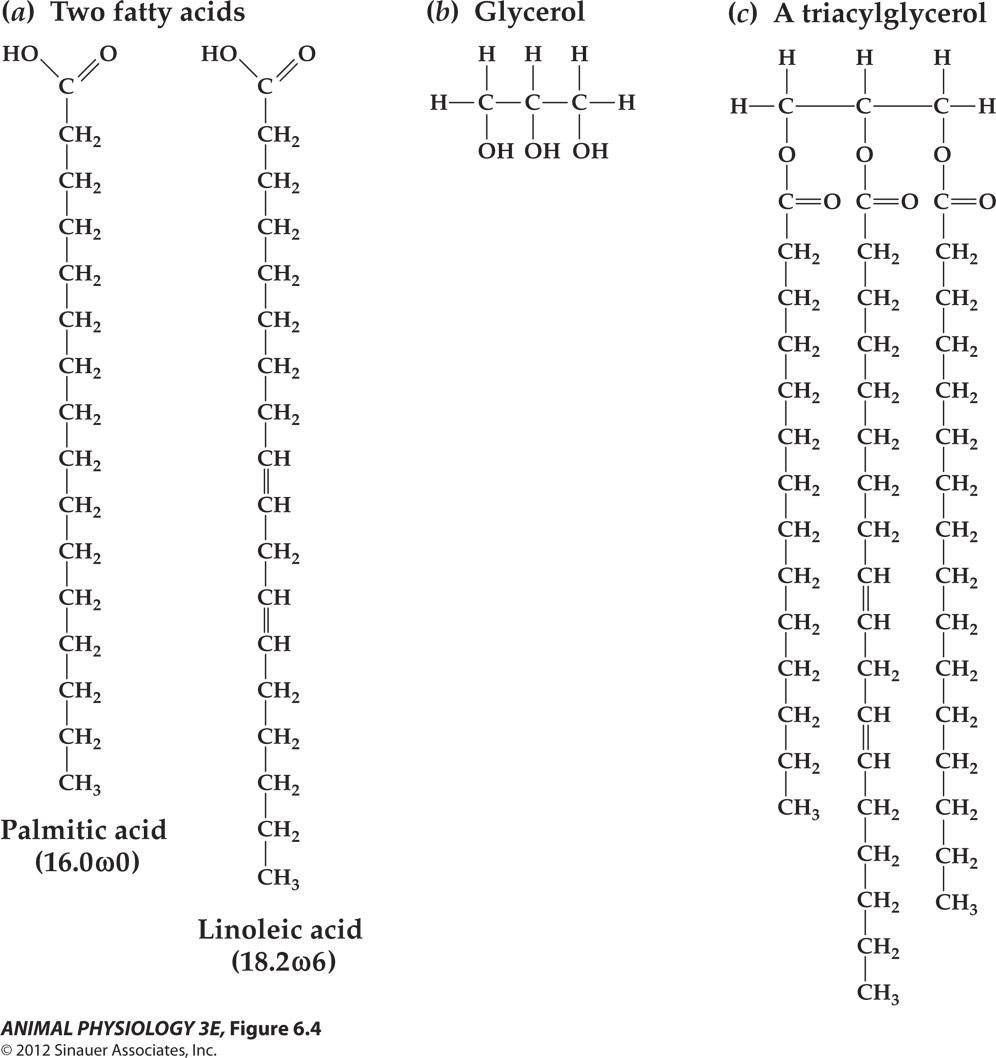
One example: $18.2\ \omega6$
- 18: number of carbons in the fatty acids
- 2: number of double bounds
- $\omega$: ends with methyl group
- $\alpha$: Fatty acids begin with carboxylic acid: –COOH
- $\omega$6: position of the first double bond from its methyl end (-CH3)
Omega 3 and Omega 6 fatty acids Nutritional value
Functions of lipids
- Principal components of the cell membrane (Structure molecules)
- lipids for terrestrial animals such as mammals and insects, to reduce the permeability of the integument to water
- Storage compounds as energy stores, because they far exceed proteins and carbohydrates in their energy value per unit of weight.
- lipids in excessive of needs are stored in their body for future use
Essential lipids: mammals lack of enzymes to create double bonds at the omega 3 and 6 positions. Therefore, omega 3, 6 must be obtained from outside sources
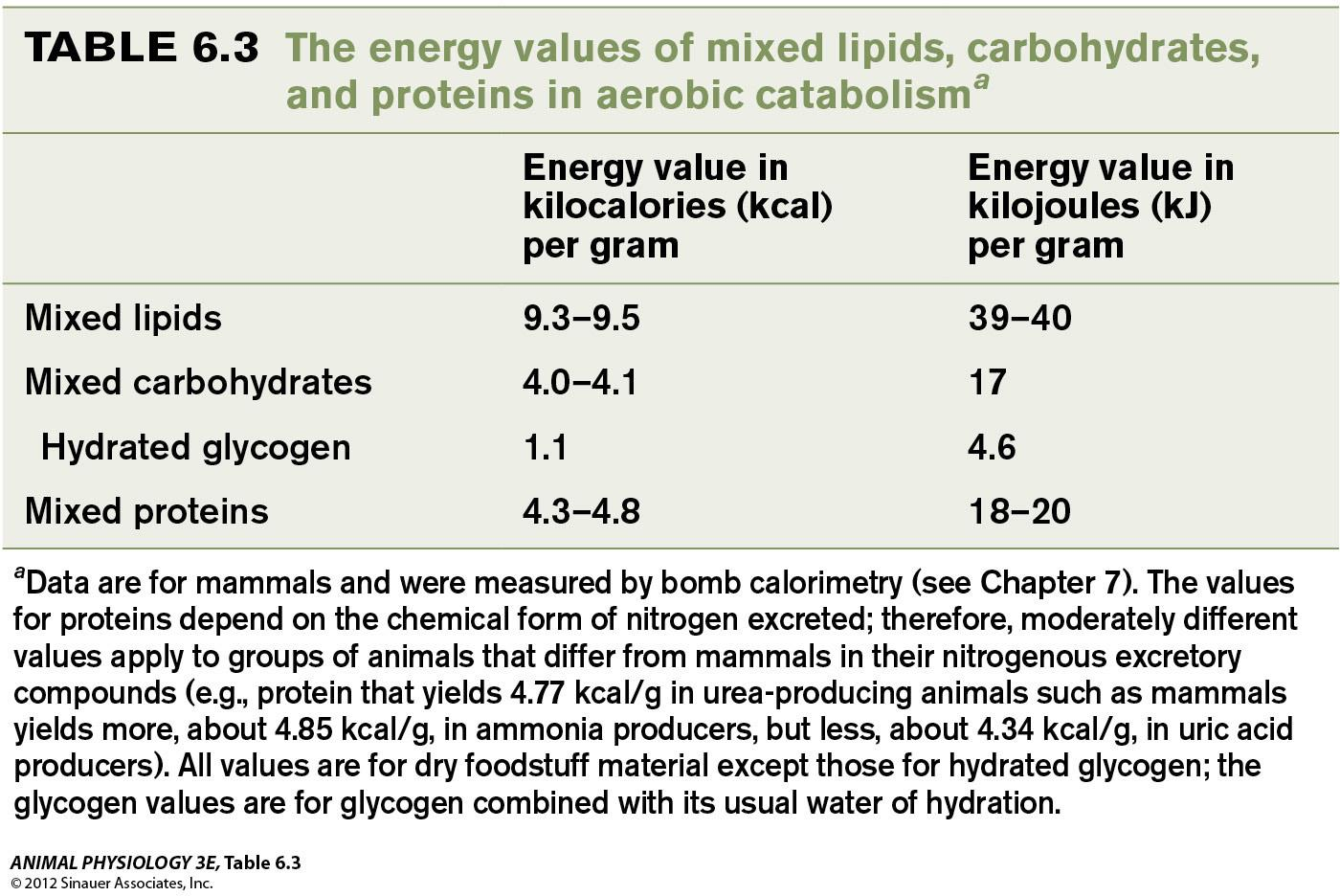
3. Carbohydrate chemistry
The simplest carbohydrates are monosaccharides

Functions of carbohydrates
Monosaccharide:
- They are the simplest form of sugar and are usually colorless, water-soluble, crystalline solids.
- Some monosaccharides have a sweet taste.
- Examples of monosaccharides include glucose (dextrose), fructose (levulose and galactose)
- Monosaccharides are the building blocks of disaccharides and polysaccharides.
Disaccharides (sucrose, trehalose (海藻糖), lactose)
Polysaccharides (cellulose and starch)
- more than 10 monosaccharides, often contains more than 100-1000 polymerized monosaccharides
- provides structural support (chitin, cellulose – the most abundant organic compounds in the biosphere.)
- Chitin and cellulose (for insects and plants)
- Energy storage compounds
- Starch polymerized glucose in plants and glycogen
- Transport compounds
- Small mono-disaccharides, glucose-”blood sugar” a principal blood transport carbohydrate
There is no essential carbohydrates, animals can synthesize all of them
4. Vitamins
Vitamins are essential organic compounds required in small amounts
- Can not be made by animals and yet required only in small amounts
Adopted by animals as a consequence of opportunism during evolution
- Vitamin A is incorporated into visual pigment called rhodopsin: animals convert vitmain A into retinal, which is conjugated with a protein opsin to form rhodopsin. The light absorbing portion is subpart of the molecule derived from vitamin. Animals must during evolution, “opportunistically” used vitamin A structure to serve as photon-absorbing portion of their visual pigments.
Structurally diverse and functionally diverse (there is no one function to describe vitamins)
Can be divided into
- water-soluble set (B and C vitamins)
- lipid soluble set (A, D, E, K)
Vitamin structures
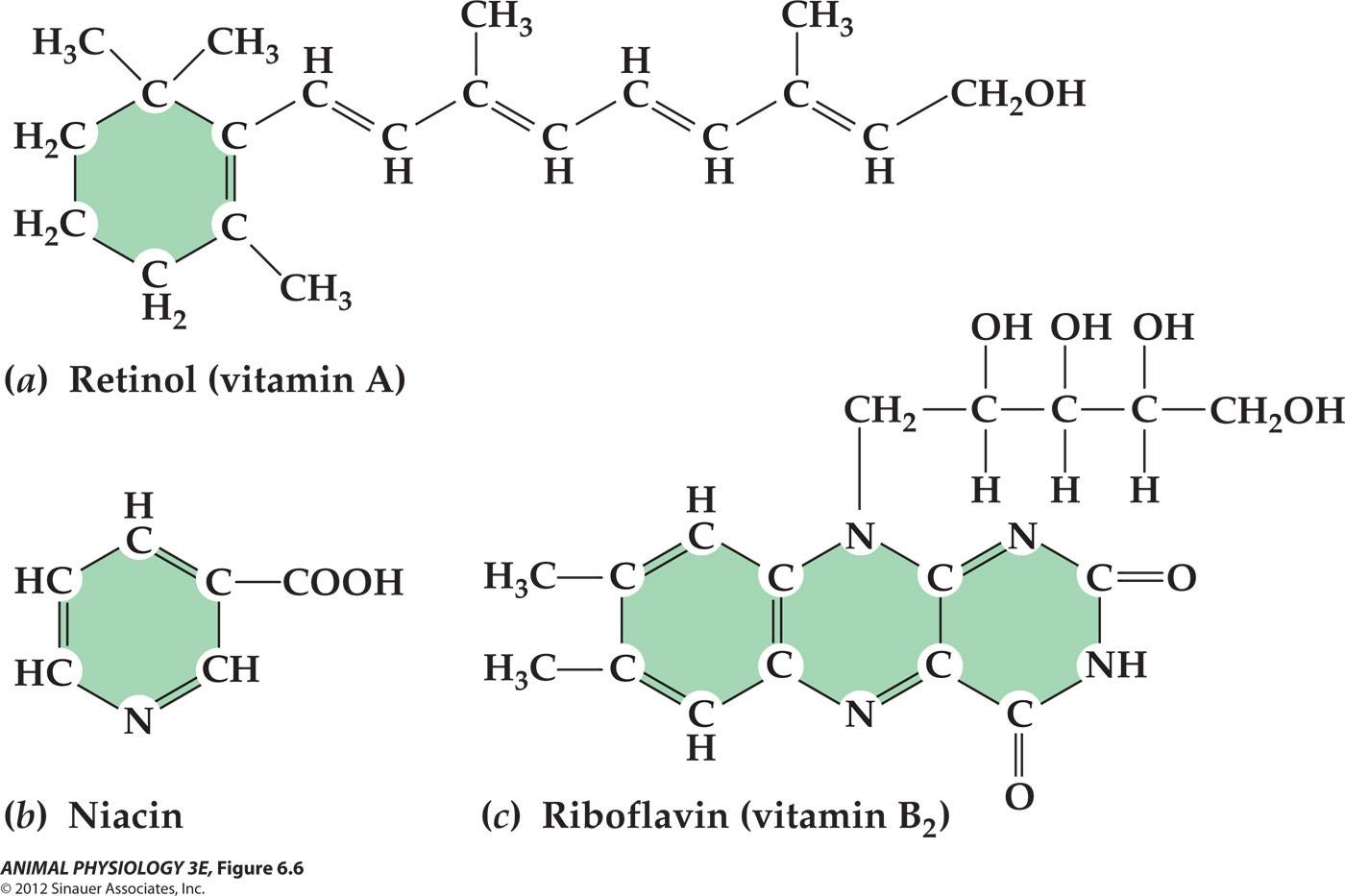
Bovine rhodopsin 视紫红质
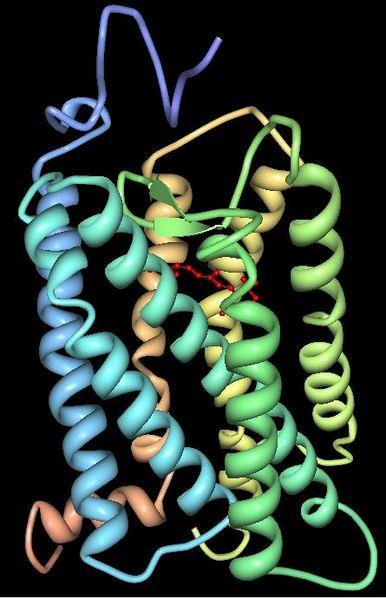
Opsins contain seven transmembrane α-helical domains connected by three extracellular and three cytoplasmic loops.
- The chromophore is shown in red.
视紫红质:
- 一种结合蛋白,由视黄醛(也称网膜素,retinal)和视蛋白(opsin)结合而成。视黄醛由维生素A氧化而形成,是维生素A的醛化合物,有多个同分异构体
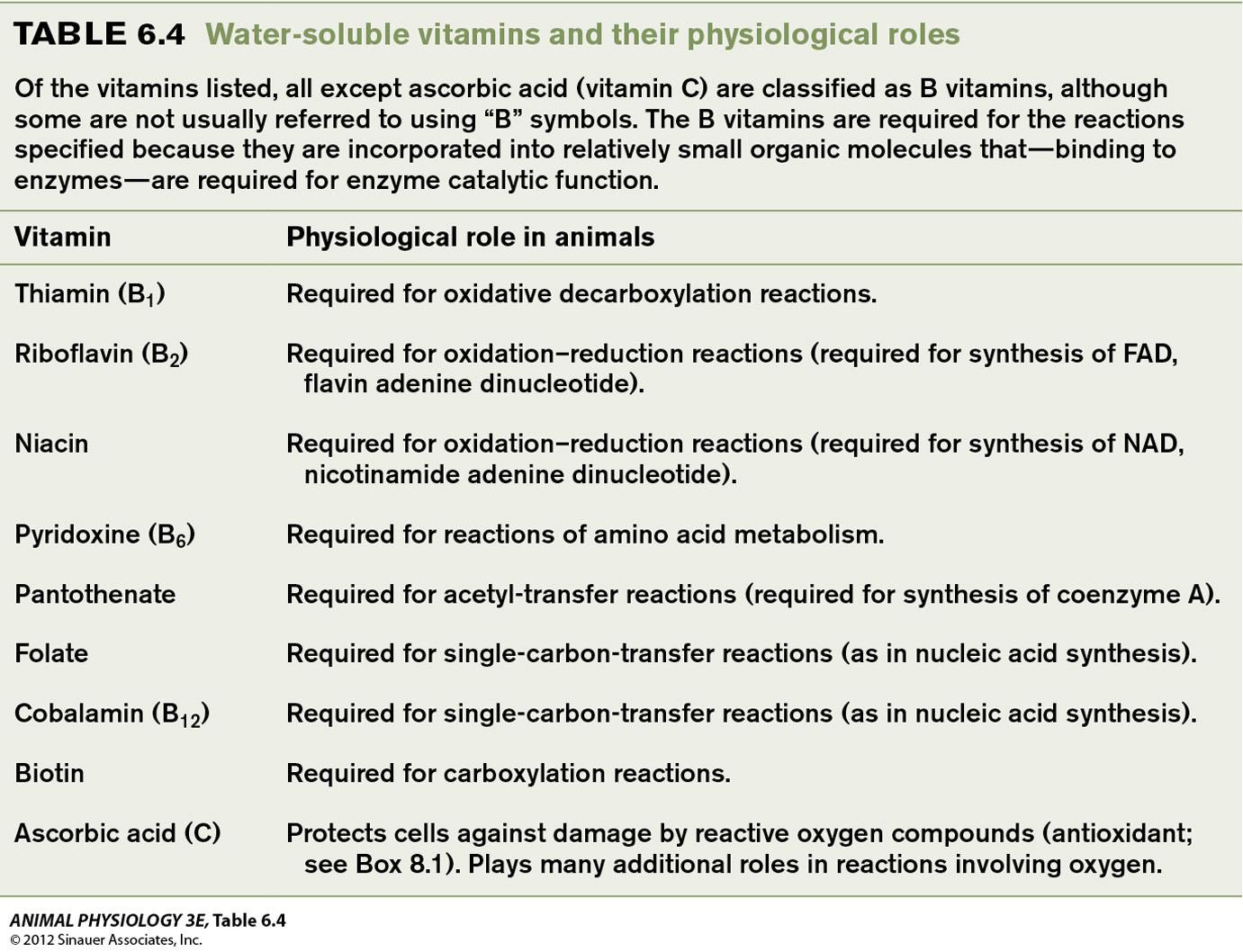
Water soluble vitamins and their functions:
| Vitamin | Physiological role in animals |
|---|---|
| Thiamin (B1) | Required for oxidative decarboxylation reactions. |
| Riboflavin (B2) | Required for oxidation-reduction reactions(required for synthesis of FAD (flavin adenine dinucleotide)) |
| Niacin (Vitamin B3) | Required for oxidation-reduction reactions(required for synthesis of NAD, nicotinamide adenine dinucleotide) |
| Pantothenate (Vitamin B5) | Required for acetyl-transfer reactions (required for synthesis of coenzyme A) |
| Pyridoxine(B6) | Required for reactions of amino acid metabolism |
| Folate (Vitamin B9) | Required for single-carbon-transfer reactions (as in nucleic acid synthesis) |
| Cobalamin (B12) | Required for single-carbon-transfer reactions (as in nucleic acid synthesis). |
| Biotin (Vitamin H) | Required for carboxylation reactions. |
| Ascorbic acid(Vitamin C) | Protects cells against damage by reactive oxygen compounds (antioxidant see Box 8.1 in textbook). Plays many additional roles in reactions involving oxygen |

| Vitamin | Physiological role in animals |
|---|---|
| Vitamin A | Light-activated component of visual pigments. Also needed for normal bone growth, reproductive function (e.g sperm production), cell membrane integrity, and other functions, but exact biochemical mechanisms are not always known. Vitamin A is a regulator of gene transcription and can cause deranged development of a fetus if ingested in artificially large amounts by the mother during pregnancy. |
| Vitamin D | Activator of pathways of calcium and phosphorus metabolism; acts by binding, like a hormone, to specific receptors |
| Vitamin E | Protects cells against damage by reactive oxygen compounds (antioxidant) preserving integrity of critical molecules, especially membrane phospholipids. See Box 8.1 |
| Vitamin K | Required for production of blood-clotting factors |
二、Feeding
Feeding–obtaining and ingesting foods
Feeding methods are very diverse in the animal kingdom –self study
Microbial populations in animal guts – gut microbiome
- Culture them is very unsuccessful, through genomics to sequence all of them and then extrapolating the species and functions.
- Colonization of the gut only begins during the birth process (microbes are acquired from the mother’s vagina) and colonization rapidly escalates as a interacts with the environment.
- Three types of composition of human gut microbiome:
- one is effective in producing biotin (Vitamin H) and riboflavin (Vitamin B2);
- another is effective in producing thiamin **(Vitamin B1)**and folate (Vitamin B9). Based on gene differences
Specialized symbioses with heterotrophic microbes
Autotrophic microbes 自养微生物
- aquatic animals uses internal algae to produce organic food molecules through photosynthetic autotrophs.
Heterotrophic microbes 异养微生物
- acquire organic compounds from external sources, and the animal gains nutrition from symbiotic association with heterotrophs. For example, heterotrophic microbes break down food materials that animals are unable to break down.
Heterotrophic microbes are typically mixed communities of bacteria, protists, yeasts and fungi – they are also called fermenting microbes
Animals maintain specialized symbiotic associations with fermenting microbes are called fermenters
Type of meal processing systems
Microbial fermentation is most effective when the old and fresh food are mixed with microbes
Enzymatic digestion of food is most effective when enzymes are mixed with fresh materials.
Reactor models applied to meal processing in animals:

- Batch reactor: Each meal is processed before the next meal enters
- Continuous-flow reactor without mixing: Meals line up in a tubular reaction vessel so they do not mix, but each can be processed for far longer than in a batch reactor
- **Continuous-flow reactor with mixing: ** New meals mix with meals that have already undergone some processing.
An optimal reactor configuration predicted from engineering models:

1. Digestive system
Human: esophagus, stomach, small intestine, pancreas, liver
人:食道、胃、小肠、胰腺、肝脏
Vertebrates and some invertebrates: headgut, foregut, midgut and hindgut
脊椎动物和一些无脊椎动物:头肠、前肠、中肠和后肠
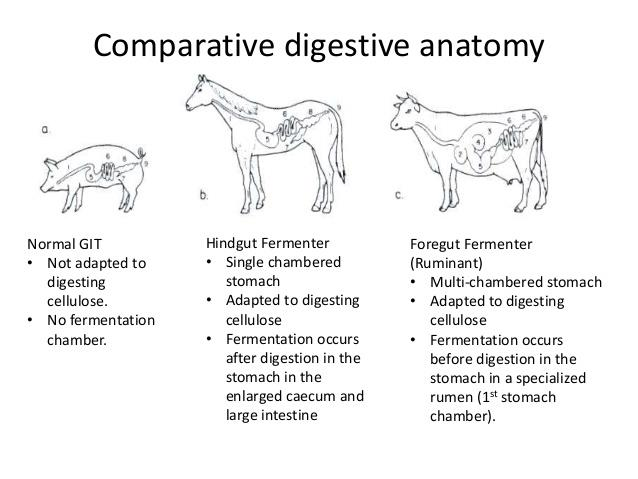
Normal GIT
- Not adapted to digesting cellulose
- No fermentation chamber
Hindgut Fermenter 后肠发酵者
Single chambered stomach 单腔胃
Adapted to digesting cellulose
Fermentation occurs after digestion in the stomach in the enlarged caecum(盲肠) and arge intestine
发酵是在扩大的盲肠和大肠的胃中消化之后发生的。
Foregut Fermenter (Ruminant) 前肠发酵者
- Multi-chambered stomach 多腔胃
- Adapted to digesting cellulose
- Fermentation occurs before digestion in the stomach in a specialized rumen(1st stomach chamber).
Vertebrate Foregut Fermenters
Foregut fermenters 前胃发酵
- Ruminant mammals (sheep, cattle, goats, deer, buffaloes..)

- breakdown of compounds that the animal can not digest (cellulose)
- Ability to synthesize (B vitamins), essential amino acids
- Permits waste nitrogen from animal metabolism to be recycled into new animal proteins rather than being excreted.
The digestive tract of ruminants (反刍动物)
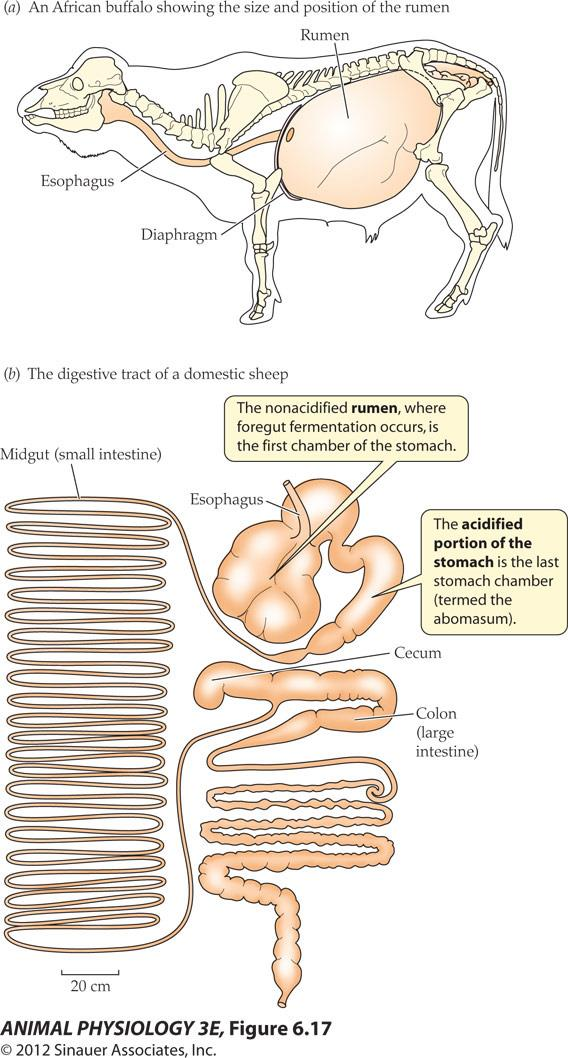
- The nonacidified rumen, where foregut fermentation occurs, is the first chamber of the stomach
- The acidified portion of the stomach is the last stomach chamber (termed the abomasum)
Rumen – 瘤胃
- less acidic to allow the growth of microbes
Three categories of functions of rumen microbials:
- Fermentative breakdown of compounds that animals can not digest.
- To digest cellulose and other carbohydrates of plant cell walls
- rumen microbial community produce a complex of enzymes called cellulase to breakdown cellulose
To produce short-chain fatty acids (volatile fatty acids)
- Short-chain fatty acids (SCFAs), sometimes called volatile fatty acids, are the principal useful products of the microbial breakdown of plant structural carbohydrates
SCFA include:
- Acetic acid (2 carbon)
- Propionic acid (3 carbon)
- Butyric acid (4 carbon)
- (these can be absorbed and metabolized by the animal)
- Short-chain fatty acids (SCFAs), sometimes called volatile fatty acids, are the principal useful products of the microbial breakdown of plant structural carbohydrates
Vertebrate hindgut and midgut fermenters
Mammalian hindgut fermenters (rabbit, horses, zebras, rhinos, apes, elephants and koalas and some rodents)
- Enlarged cecum or colon where microbial community reside
The role of microbials in vitamin B and essential amino acid and recycling of nitrogen are not fulfilled in the same way in hindgut fermenters as in foregut fermenters
- For example: vitamin B is not absorbed in the small intestine and is lost in the animal feces; essential amino acids are also lost. Solution – hindgut fermenters eat defecated materials (后肠消化的动物吃自己的粪便补充损失的维生素).
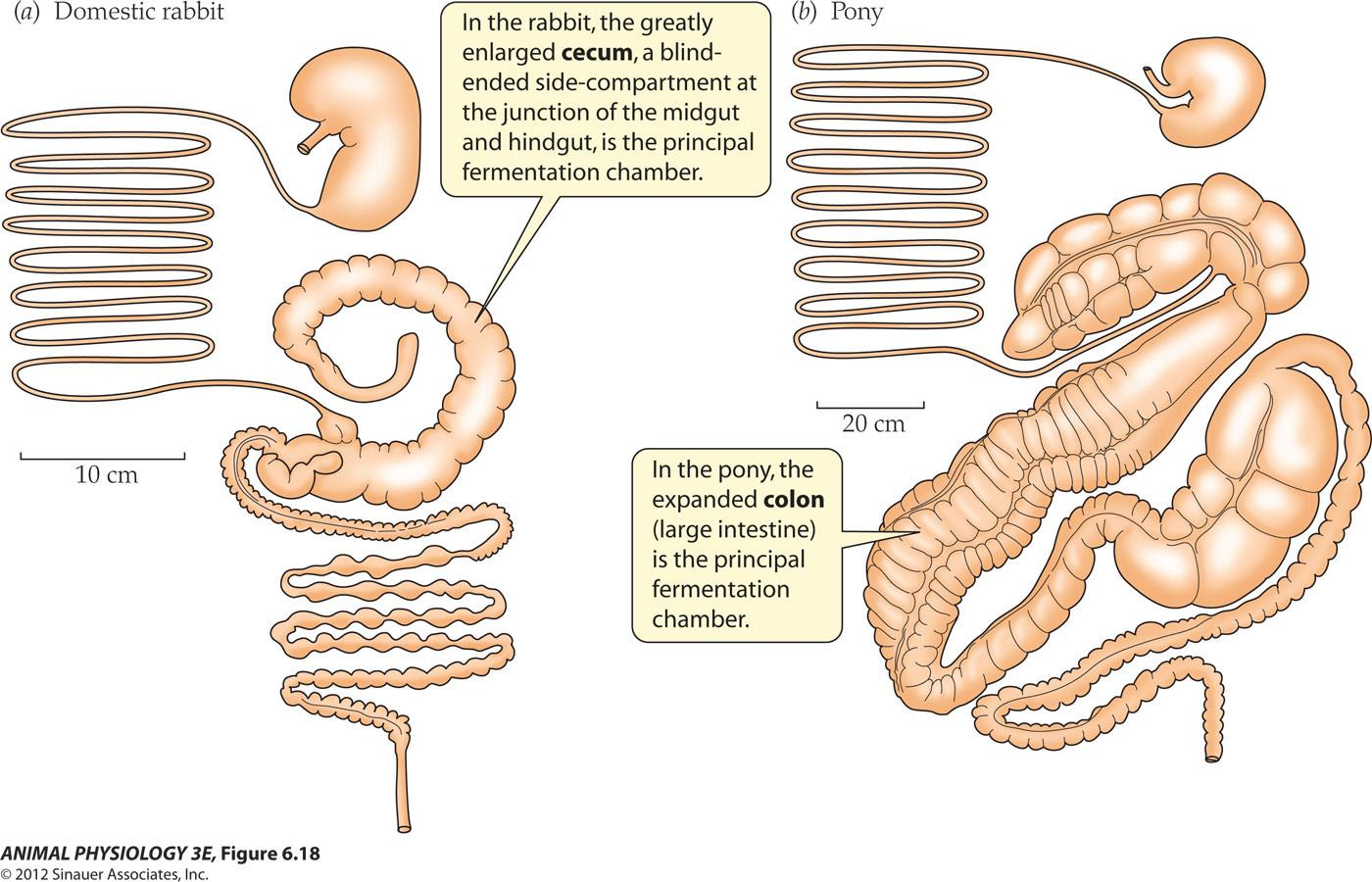
- In the rabbit, the greatly enlarged cecum, a blind ended side-compartment at the junction of the midgut and hindgut, is the principal fermentation chamber
- In the pony, the expanded colon (large intestine) is the principal fermentation chamber
三、Digestion
Digestion is carried out by specific enzymes operating in three spatial contexts
Digestion: the breakdown of food molecules by enzyme action (or other animal-mediated processes) into smaller chemical components that an animal is capable of distributing to the tissues of its body, mostly by hydrolytic enzymes
- Extracellular digestion: is the digestion in the extracellular body cavity such as stomach or intestine.
- Intracellular digestion: is the digestion occurred within the cells (many invertebrates, sponge, flatworms etc).
In all animals, digestion is carried out by hydrolytic enzymes through hydrolytic reaction.
- Each digestive enzyme is specific in the type of chemical bond it can break
- The nutritional value of food depends on the digestive enzymes an animal possesses, not the chemical composition of the food
The three spatial contexts in which digestive enzymes work in animals:
- Intraluminal enzymes: digestive enzymes are secreted into the lumen of the body cavity (stomach, midgut) to mix freely with the food. (a type of extracellular digestion)
- Membrane-associated enzymes: digestive enzymes synthesized by the epithelium lining the gut (also a type of extracellular digestion).
- Intracellular enzymes: food particles are taken into the cells where the digestive enzymes are located.
Carbohydrate digestion
Disaccharides are hydrolyzed into two monosaccharides by disaccharidases (sucrase and others)

Disacchatidases are membrane associated enzymes located on the apical membrane of the midgut epithelium
Polysaccharide is digested by two enzymes acting in sequence:
- the first enzyme splits the polysaccharide into disaccharides or oligosaccharides;
- the second enzyme breaks the products into monosaccharides;
- The first enzymes to act on starch and glycogen, two major storage polysaccharides, is amylase. It hydrolyzes both to yield disaccharides maltose, isomaltose and oligodaccharides. Then maltase, a disaccharidase and other enzymes.
- In mammals, amylase are present in the saliva and the pancreas juices.
Cellulase and Chitinase (exoskeletons of insects) can not be made by vertebrates and are provided by symbiotic association with microbes.
Protein digestion
Protein digestion involves a much larger array of enzymes than carbohydrates because of the diversity of types of chemical bonds that must be hydrolyzed.
Two categories of enzymes break proteins and polypeptides:
- Endopeptidases (内肽酶,肽链内切酶)
- exopeptidases (外肽酶,肽链端解酶)
- These enzymes also have the potential to break the animal tissue. So these enzymes are made in an inactive form called proenzymes or zymogens and only become activated once arriving at the site of action
Stomach: Pepsin (requires acid condition to activate pepsinogen, a proenzyme).
Midgut: pancreas secrets proenzymes which as activated by midgut enzyme-catalyzed cleavage reactions that release the active peptidase.
For example:
- endopeptidase: trypsin, chymotrypsin, elastase and collagenase (胰蛋白酶、 胰凝乳蛋白酶、弹性蛋白酶和胶原酶).
- exopeptidase: carboxypeptidases A and B
The end product is free amino acids and short amino acid chains called oligopeptides
- membrane bound endoexo-peptidases (20 of them) to further process oligopeptides to yield free amino acids, dipeptides and tripeptides. Absorbed by epithelial cells in the midgut and further processed by intracellular peptides to yield free amino acids., which passed to the blood.
The digestion of a short protein by three pancreatic peptidases, each specific for particular types of peptide bonds

Lipid digestion
Chemical bonds in lipids are less complex than those of protein.
Lipids digestion depends on fewer enzymes and non-enzymatic emulsifying processes that break up lipids into small droplets.
- Emulsification can be brought about by mechanical agitation or chemical action (机械搅拌或化学作用).
The midgut is the principal site for lipids digestion in vertebrates.
Lipases are the main digestive enzymes of lipids. It works on the lipid-water interface.
- Pancreas secrets pancreatic lipases.
Midgut secretes chemical emulsifying agents - bile salts and other bile constituents, which are amphipathic molecules act as detergents dispersing lipids into droplets with large surfaces where lipases can work. (bile salts are reabsorbed at the terminal portion of the midgut back to the liver biliary system and re-secreted upstream. The same bile salt molecule will be recycled this way several times during the same meal.
The products of fats and oils (triacylglycereols) digestion are free fatty acids, glycerol and monoacylglycerols
Phospholipases and esterases is responsible for phospholipids and cheolesterol esters

Monoacylglycerol:
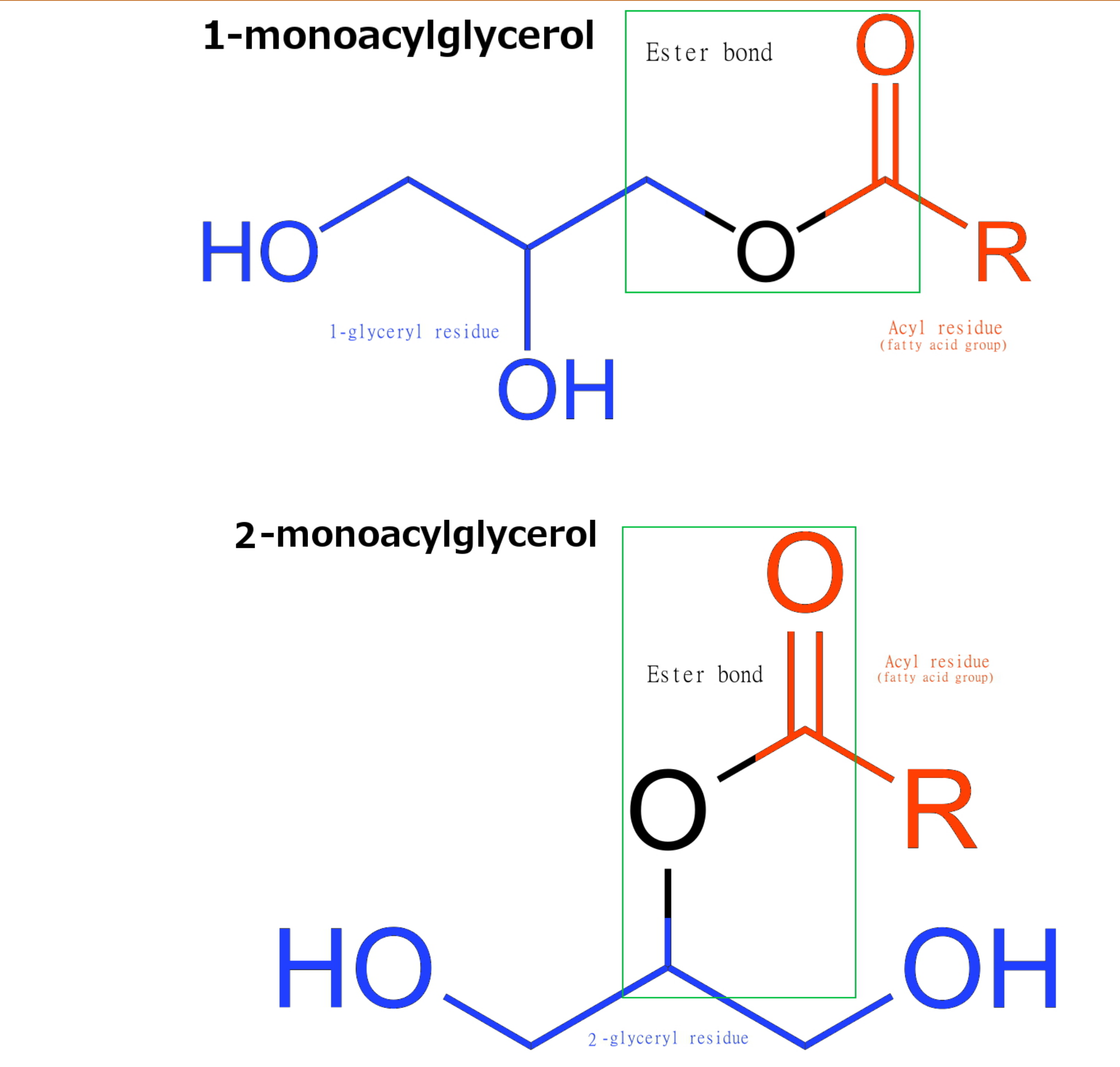
四、Absorption
Absorption: transfer of products of digestion from the lumen of the gastrointestinal tract to the blood or lymph
Free amino acids, free fatty acids and monosaccharides.
Three mechanisms of transportation are involved in absorption: simple diffusion, facilitated diffusion (both are passive) and active transport (another one is called solvent drag due to osmotic water movement).
Free amino acids, monosaccharides, and water-soluble vitamins are hydrophilic and can NOT pass the cell membrane by diffusion.
- No channels for it.
Glucose is the best understand example of facilitated diffusion: passive transport by noncovalent and reversible binding with solute-specific transporter (a co-transporter: sodium-glucose transporter 1 SGLT1).
passive: because it is in the electrochemical equilibrium (diffusion)
Facilitated: by a transporter to move faster
Not a simple diffusion: because solutes bind reversibly with the transporter protein
The structure of the vertebrate midgut and the mechanism of absorption of monosaccharides (glucose, fructose, and galactose)
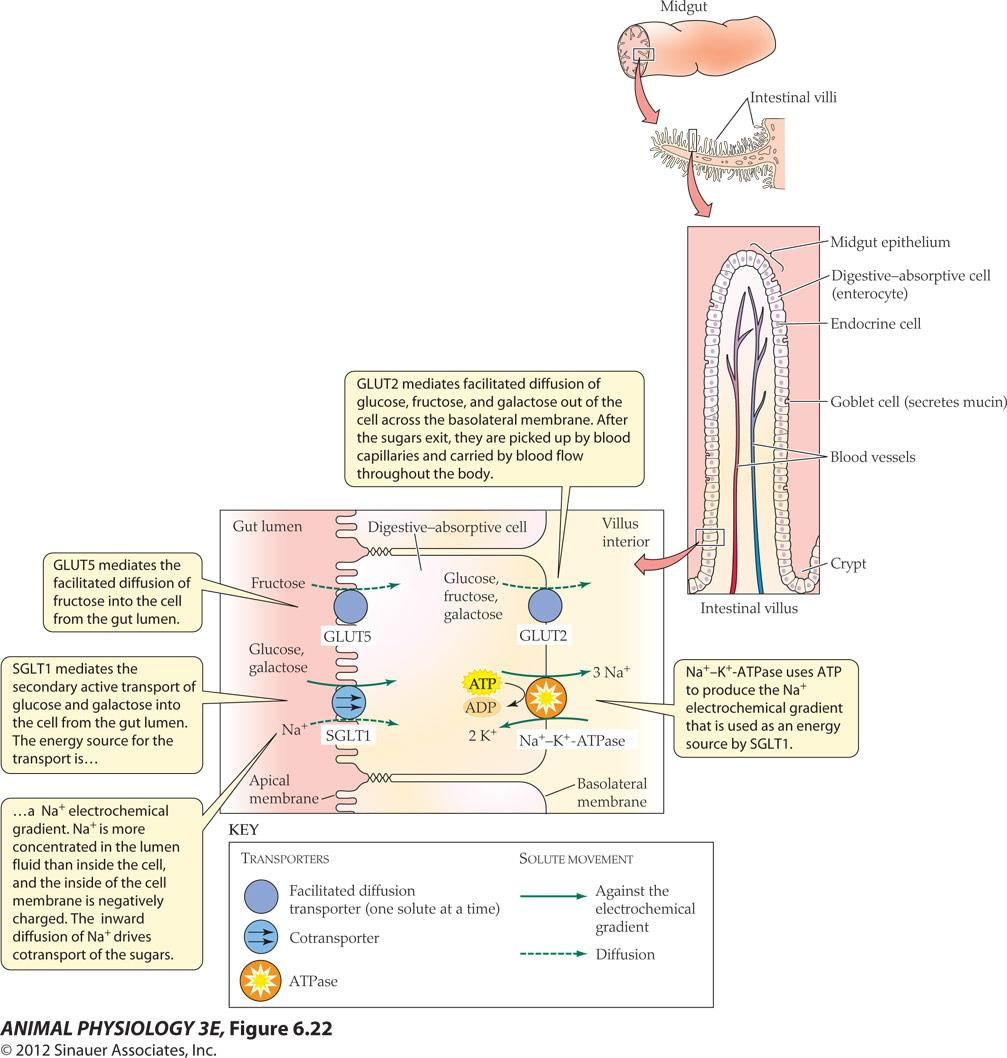
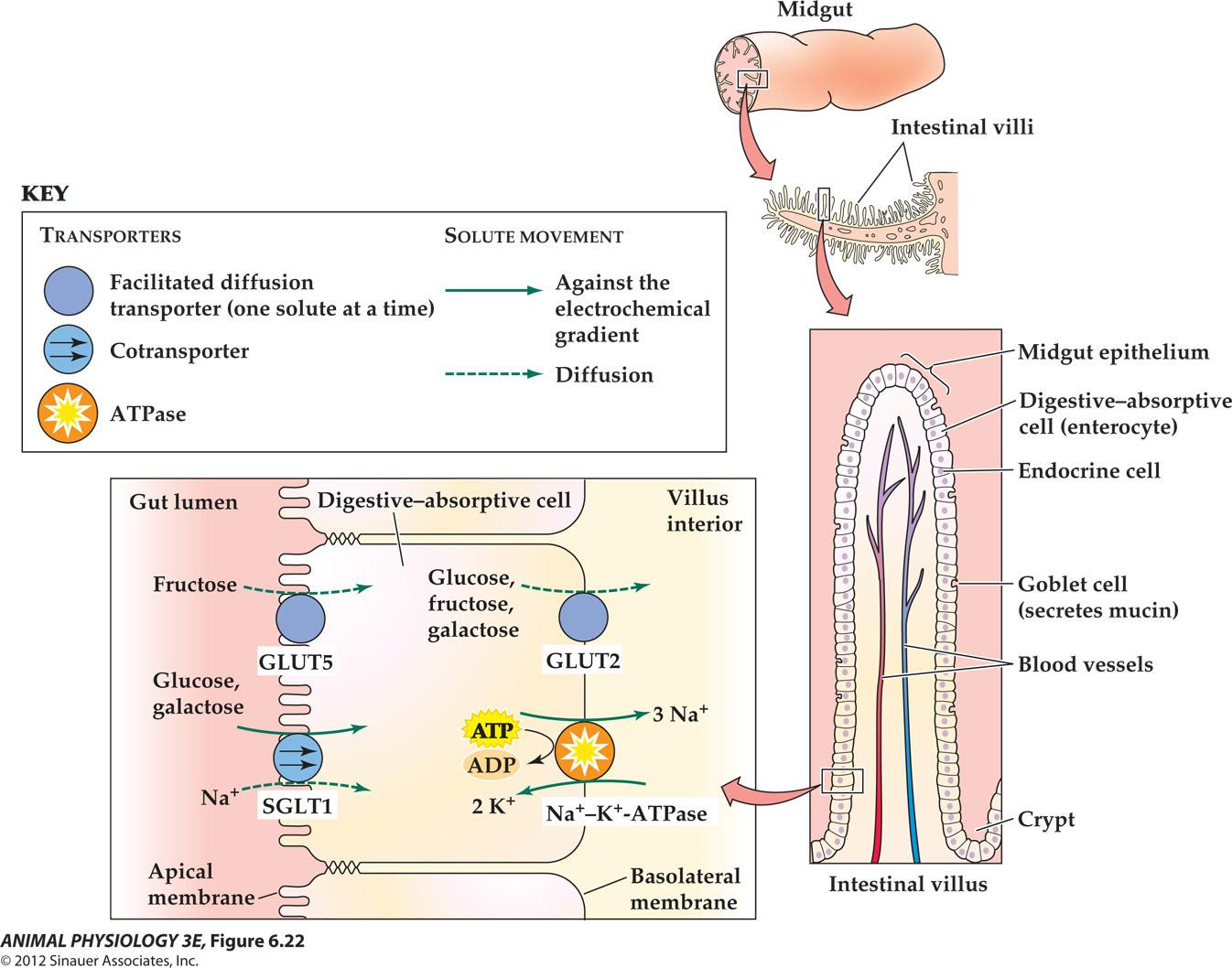
Amino acid and water-soluble vitamin absorption
Very complicated due to the diversity of amino acids – not thoroughly understood
Seven distinct transporter proteins are found on the apical and brush boarder membrane of epithelial cells.
Some B and C vitamins use Na^+^-driven active transport (secondary active transport).
Lipids absorption
Fatty acids and monoacylglycerols are hydrophobic and can dissolve in the lipid rich interior of cell membrane –therefore most lipids are by simple diffusion
- Some active transport occurs.
In the midgut, fatty acids monoacylglycerol combined with bile salts to form aggregates micelles (less than 10 nm) through emulsifying effects
Micelle does not get absorbed, instead, fatty acids and vitamins dissociate from micelle and next to the apical membranes of gut epithelial cells
Once inside cells, enzyme-catalized production of triacylglycerols, phospholipids and cholesterol esters form, They complex with proteins to form lipoprotein molecular aggregates (chylomicrons乳糜微粒), which is amphipathic (两亲的)

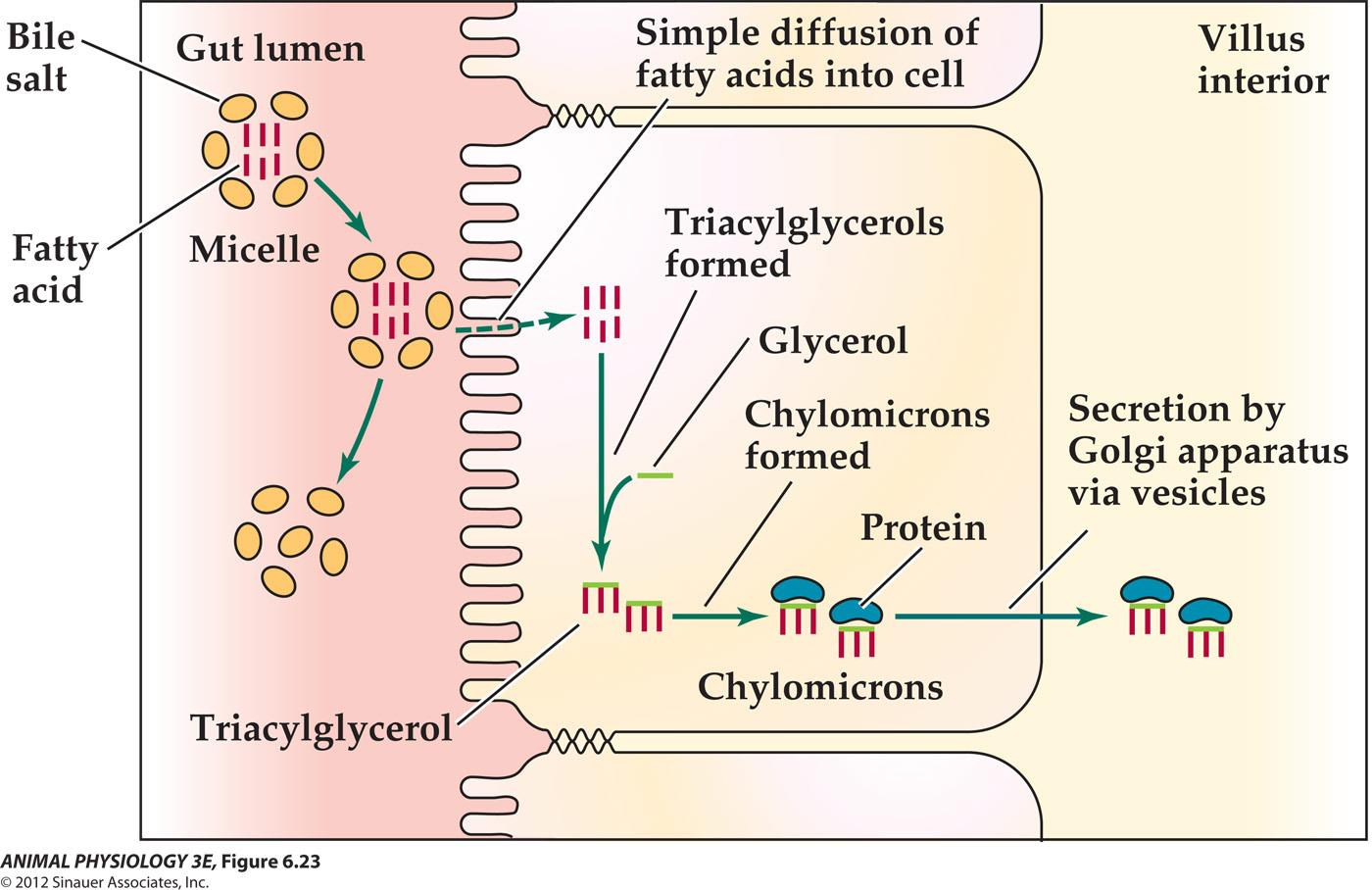
Gastrointestinal function after a meal is coordinated in part by hormones secreted by endocrine cells in the gut epithelium

For Humans, the midgut is the principal site of both digestion and absorption
Stomach wall muscles are controlled by Autonomic commands from the Parasympathetic nervous system
The presence of food in the stomach Exerts mechanical and chemical effects On endocrine cells G cells to Secrets gastrin.
- Secretin分泌素
- Cholecystokinin (CCK)胆囊收缩素
- Gastric inhibitory polypeptide (GIP)肠抑胃肽
Midgut motility
Controlled by a complex of hormonal and neuronal influences ( stimulatory and inhibitory)
Segmentation is the principal type of midgut movement (pushes the content back and forth to mix with the digestive enzymes)
Midgut also exhibits progressive, peristaltic contraction that moves the content to the hindgut
1. Segmentation 分节运动
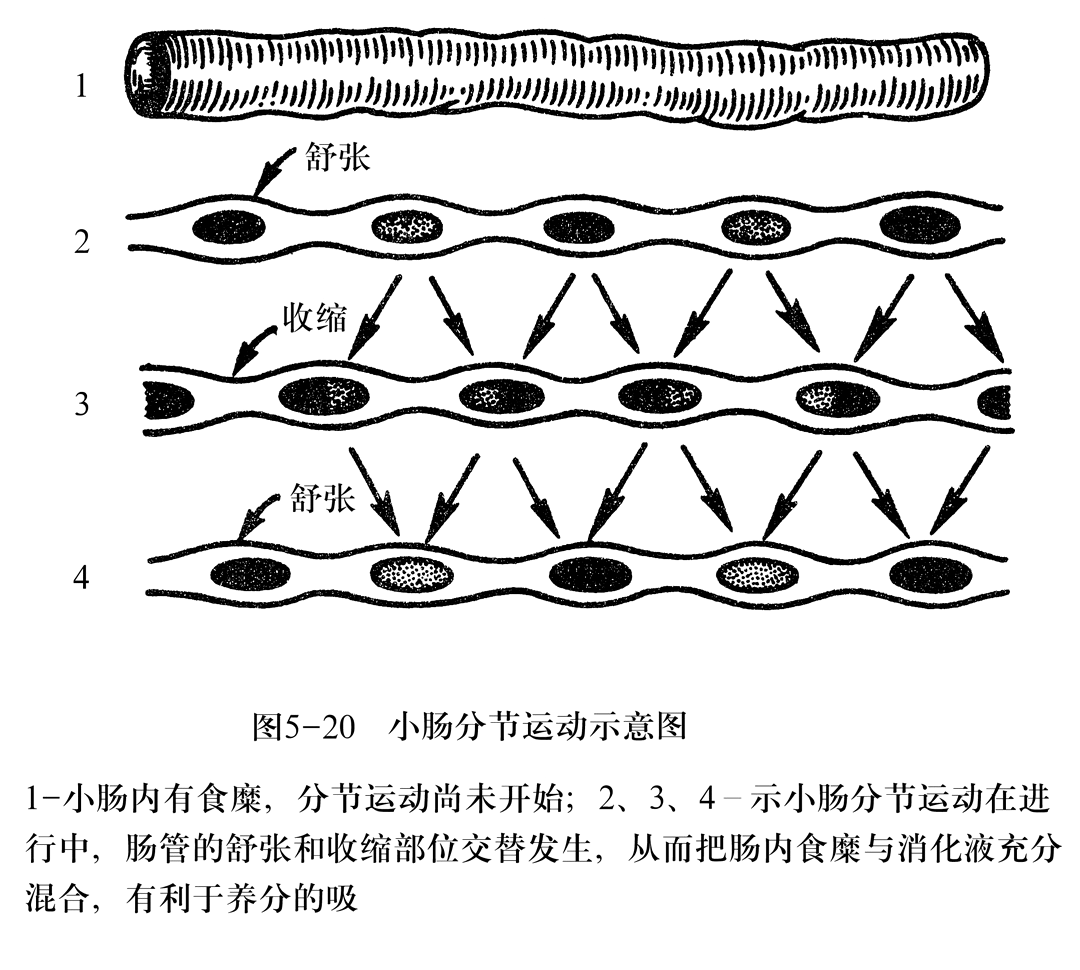
Nutritional physiology is endogenously programmed to change over time:
Nutritional physiology often undergoes developmental programmed changes
- lactase story-adult stop synthesizing lactase when they become old enough
- Amphibians are dramatic: tadpoles are herbivores/omnivores and adults are carnivores
Biological clocks controlled periodically repeating programmed changes in nutritional physiology
- Disaccharidases in the midgut apical membrane of epithelial cells of the laboratory rats (nocturnal) are up-regulated in the night and down-regulated during the day under the control of an endogenous biological clock.
- Annual fattening cycles of some mammals and birds are the most dramatic – Circannual biological clocks discovered in ground squirrels during annual cycles of fat storage research!
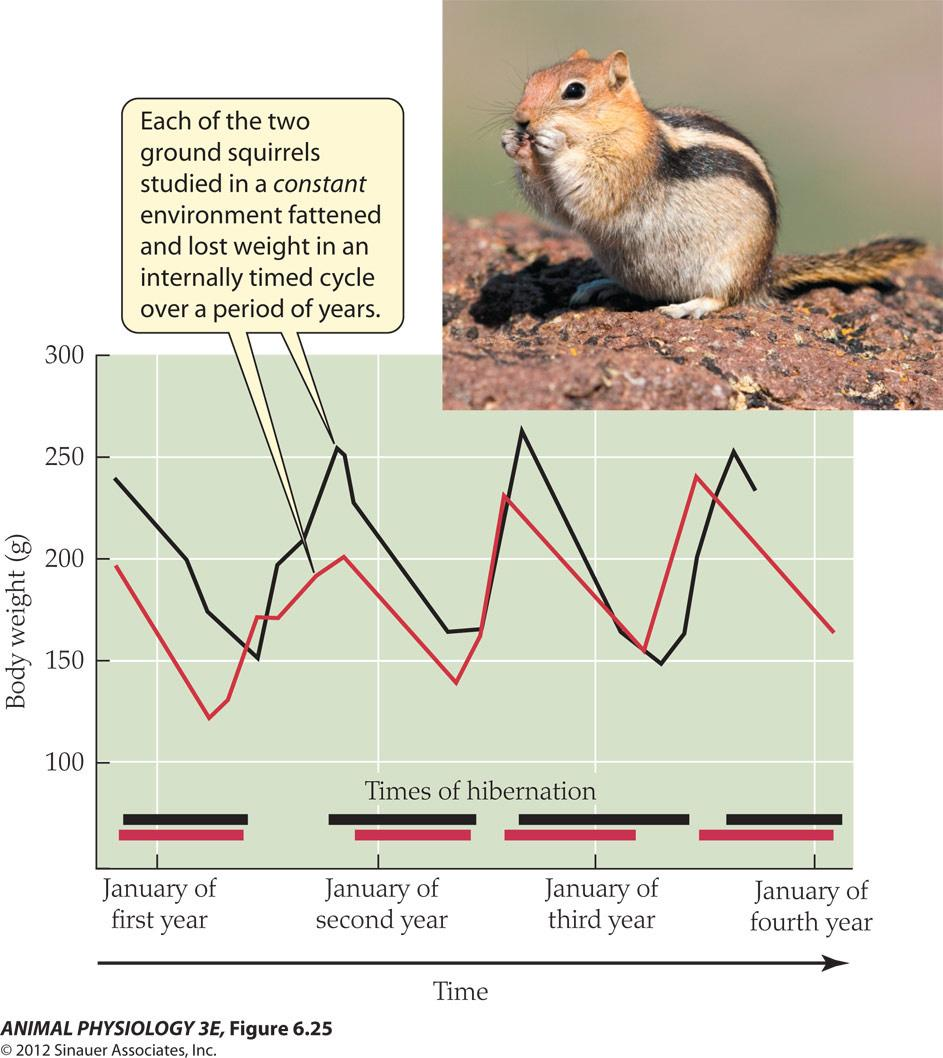
Discussion questions:
- Malnutrition of children is a profound global problem, and protein deficiencies are the most common form of childhood malnutrition. Why are people so vulnerable to protein deficiencies?
- Explain how and why the absorption of hydrophobic and hydrophilic organic molecules differs.
- List three major roles played by each class of foodstuffs: proteins, carbohydrates, and lipids.